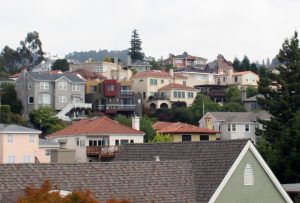–Published on OaklandNorth.net on October 19, 2011–
Robert Pennell shifted the gear to neutral and parked the car along the side of the road. “There,” he said, pointing out the open window to a cluster of houses across the street. “That one is modern and the one next to it is traditional. Then you have a contemporary California ranch style house and over there you have an English Tudor.”
A partner at Jarvis Architects, Pennell navigates the narrow hillside streets with an ease that comes from years of driving through and working on the homes in this post-fire destroyed Oakland Hills neighborhood. Although there are some trees, they are young and sparse, and the streets are drenched in sun, causing Pennell to squint behind his gold-rimmed sunglasses. It wasn’t just the houses that burned, he said—much of the vegetation, including the canopy of trees that once shaded the streets in this sleepy, secluded neighborhood, were burned, too.
“Everybody says it was so much prettier before, but what was pretty was there were a bunch of trees there,” said Pennell, his maroon PT Cruiser zipping through block after block of homes he helped to design. “Most of the houses were actually very shitty.”
On October 20, 1991, the hills above North Oakland and South Berkeley were prey to a three-day urban fire that destroyed over 3,500 homes and instigated a building revolution that permanently transformed the neighborhood for decades to come. Before the fire, the hillside was littered with small, older homes, some dating as far back as the 1920s and 1930s. They had a very traditional feel to them, Pennell said, and consisted mainly of French and English cottages and colonial style homes.
But after the fire, the Oakland hills neighborhood drastically transformed into a community of clashing architectural styles, innovative designs, and large, looming structures. Many residents got large insurance settlements for their homes after the fire which allowed them to build extravagant new houses. Builders and developers also zeroed in on the area constructing larger, more expensive homes in the hopes of reaping a higher benefit. Modern materials such as cement panels, copper shingles, corrugated metal, Japanese ceramic tiles and smooth stucco now cover formerly shingled cottages and colonial houses. A hodgepodge of styles—ranging from Mediterranean and Tudor to modern and Craftsman—can now be found on the same block.
Residents saw the fire as an excuse to build the house they always wanted, said Pennell, and developers and architects followed their lead. “These people got a do-over, and if they had enough cajones to actually do it, that was pretty cool,” he said.
Many residents, however, had more modest plans for reconstruction and wanted to rebuild what they had lost, he said, but with a modern twist. “They wanted to feel like they were coming home, but they didn’t want it to be the very home they left,” Pennell said. “Although they had bought the house that they liked, if given the option, they were like, ‘Well, I can tweak it a bit.’ It’s like ordering off the menu and deciding to add a little ketchup on it and a side order of fries.”
Homes that had once had two or three bedrooms were rebuilt with four or five. Hallways were widened. Kitchens were opened up to the family room. Bathrooms were added, and garages were expanded to fit multiple cars.
“Everyone loves an old house, except when they have to live in it,” Pennell said. “And that’s how we put our practice together: Keep the pieces of the old house that people loved, but adapt the old house to the way people live now. People do not live the way they did when these old houses were built.”
As a result, the houses in the neighborhood became larger. “If you are selling a house, you have to appeal to the mass market,” he said. “You had to have a certain amount of stuff in there, which usually makes the house bigger than what was there before.”
Developers also decided to make the most of the empty space by building the new houses right up to the edge of the lot line. “The lots used to be rather large with a small house on it,” said real estate agent Dee Knowland of Pacific Union International, who sold more than four dozen newly constructed homes in the area. “But when a builder comes along, what do you think he’s gonna do? He’s gonna build a great big house so he can sell it because price per square foot is more.”
As the house sizes increased and luxury features were added—Knowland has sold houses that have home theaters, wine cellars, and master bathrooms with Whirlpool bathtubs—the cost of these houses also increased. Before the 1991 fire, the median price of homes in the Oakland Hills was $300,000. After the fire, prices dropped and developers were able to snatch up vacant lots at lower prices. However, by the mid- to late-‘90’s, many houses were rebuilt and their cost jumped in price to an average of $700,000. Today, many houses in the Oakland Hills are valued in the $1 to $4 million range, said Knowland.
Another reason why the rebuilt houses became increasingly elaborate was that residents who had lost their homes got large insurance settlements, said developer Leonard Perillo of Leonard R. Perillo Investments. “People got huge settlements,” he said, because the replacement cost and construction methods of the older houses were so rare that reconstruction estimates soared. “A lot of people became ‘fire millionaires,’ and so they started building some pretty awesome houses based upon having the money to do it.”
Not to mention, said Knowland, the area has always commanded higher home prices, given its desirable location. “It’s an area that has always housed wealthy people because of the university, the views, the nearness of the city, and the weather,” she said.
But the grandiose sizes of the new houses rubbed some residents the wrong way. Houses that had once had front and back yards now lack both because the structure takes up too much space. Neighbors often complain about the lack of privacy that is the result of larger houses built above them on the hills.
“It’s all very cheek-to-jowl and there are very large houses on rather small yards,” said Ellen Peterson, a former board member of the Rockridge Community Planning Council. “I was upset that the city of Oakland didn’t do anything about it. There seemed to be no limit to how large they could grow.”
Pennell said he understands why residents were at first upset with the new structures, but said that the main reason the new houses seemed so ostentatious was the lack of greenery after the fire. “What happened is you built a bunch of bigger, new houses and with no trees around them to cover them up, everybody became horrified,” Pennell said. “What changed is the houses in the area became art, as opposed to just a place to live. And it’s actually quite fun.”
Perillo, who built more than 50 houses in the neighborhood after the fire, is fond of the incongruity of housing styles, shapes, and sizes because of what it says about the community on a broader level. “Just as there’s a diversity of people and types of people, there’s a diversity of the residences they live in,” he said.
Oakland Hills resident Katherine Leiper, 23, who enjoys taking her dog on walks through the neighborhood, said she distinctly remembers the fire, and currently lives in one of the few remaining houses from the 1920s. She said that the mix of architectural styles give the neighborhood character. “It’s pretty weird, but it’s the only place where I’ve ever seen this sort of thing happen,” she said. “If you go to other neighborhoods, all of the houses are pretty much the same, obviously built by the same architect or in the same style. But it’s kind of cool that there seems to be not those kinds of restrictions on what sort of house you can build here.”
After 2000, construction in the area decreased, although there are still a handful of empty lots and houses under construction. “They’re still building here and there,” said Pennell, “but it’s slowing down.” Because of the recession, it is now more expensive to build a house and developers are less likely to make a profit from it. Vacant lots, he said, will remain empty, with developers or owners holding on to them until the economy improves.
Today, older houses that survived the fire are interspersed with their newer, behemoth brethren on sites that were once charred wastelands. It’s a region that reflects the distinctly diverse nature of the residents who live there.
“Survivor. New house. All new houses. Maybe a survivor,” Pennell said, pointing his finger out the window as he zigzagged through the hilly neighborhood. “It’s a groovy, crazy place, and you never know just what to expect.”

